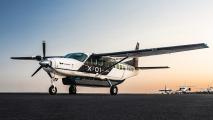On July 8, an uncrewed boat called the Saildrone Surveyor arrived in Hawaii. It was the culmination of a historic ocean-mapping journey that began in San Francisco 28 days earlier.
It’s not the first time an autonomous boat has made a Pacific crossing, but Surveyor’s trip is the most comprehensive seafloor-mapping operation ever conducted by an uncrewed boat.
Measuring 72 ft in length and weighing 14 tons, the Surveyor carries a range of instruments, sensors, and other equipment normally reserved for ships with human crews. It relies on wind and solar energy as its primary power source, and is capable of high-resolution mapping of the ocean floor to a depth of 23,000 ft.
“This successful maiden voyage marks a revolution in our ability to understand our planet.”
Richard Jenkins
Across its 2,250-nautical mile journey, the Saildrone mapped 6,400 sq mi. of seafloor.
“This successful maiden voyage marks a revolution in our ability to understand our planet,” Saildrone Founder and CEO Richard Jenkins said in a statement. “We have solved the challenge of reliable long-range, large-payload remote maritime operations. Offshore survey can now be accomplished without a large ship and crew.”
Despite covering more than two-thirds of the planet, only about 20% of the ocean is mapped. Conventional survey ships can cost hundreds of millions of dollars to build, with additional costs hitting six-figures per day for crews, fuel, and maintenance. The Surveyor does it at a fraction of the cost.
This data can help generate insights around issues related to climate change, maritime safety, marine life protection, and resource management. Jenkins also imagines use cases for the Surveyor in homeland security and defense.
Following its successful voyage, Saildrone now plans to build a fleet of Surveyors, which will further the company’s goal of mapping all the seafloor on Earth in the next ten years.
*We’d love to hear from you! If you have a comment about this article or if you have a tip for a future Freethink story, please email us at tips@freethink.com.*






